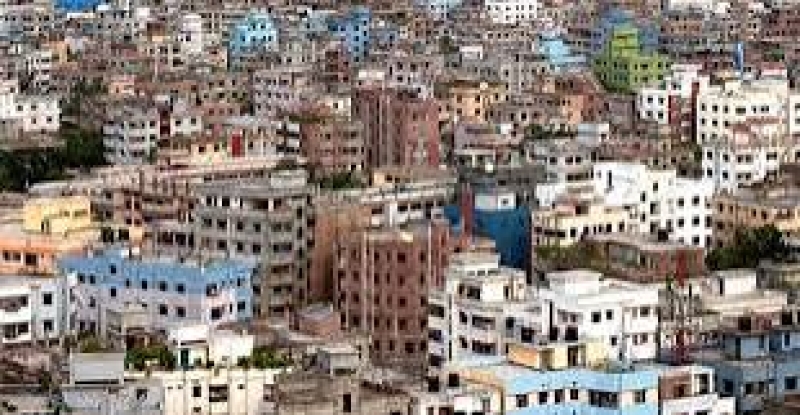- Dhaka records unhealthy air quality on Sunday morning |
- Govt letter to EC to hold election, referendum on same day |
- COP30 boosts funding for at-risk nations but avoids firm fossil fuel terms |
- When To Worry over Ceiling & Wall Cracks After An Earthquake |
- Stock market rebounds, DSEX gains 166 points over week |
Dhaka can’t withstand major quake; 95% of its buildings unplanned: Experts

Dhaka, one of the world’s most densely populated megacities, may face a catastrophic humanitarian disaster if struck by a major earthquake, leading geologists and engineers have warned.
Multiple assessments indicate that more than eight lakh of the capital’s 21.45 lakh buildings could collapse if a quake of magnitude 7 or higher hits the region.
Poor enforcement of the national building code, unauthorised construction, flawed designs and decades of lax oversight have placed the city among the most earthquake-vulnerable capitals in the world, according to the experts.
A Warning Jolt
On November 21, Dhaka and surrounding districts experienced severe shaking from a magnitude-5.7 earthquake. At least 10 people were confirmed dead and more than 100 injured.
A magnitude-3.3 aftershock struck Narsingdi area the following morning and evening, heightening concerns that a larger and more destructive quake may be imminent.
Bangladesh’s leading geologists say the quake was not an isolated event, but a precursor to something more dangerous.
‘Plate Lock Has Opened’
Dr Syed Humayun Akhter, former professor of geology at the University of Dhaka and former vice-chancellor of Bangladesh Open University, told UNB that the earthquake originated along the boundary of the Burma Plate in the east and the Indian Plate in the west. “This plate boundary had been locked for many years. The magnitude-5.7 event has unlocked it,” he said.
According to him, Bangladesh narrowly avoided a far worse disaster. “We are fortunate the quake was not magnitude 7 or 7.5. But such a major earthquake may happen in the near future.”
Research shows that the region has accumulated enough tectonic stress to trigger a quake as powerful as magnitude 8.2 to 9, Dr Akhter added. “Only a tiny amount of that energy was released this time.”
He said Friday’s shaking was among the strongest felt in recent memory, with a shallow depth of just 10 kilometres—making it far more damaging.
Bangladesh Sits on Three Active Plates
Dr Anwar Hossain Bhuiyan, professor at the University of Dhaka’s Department of Geology, explained that Bangladesh lies near the junction of three major tectonic plates—the Indian, Burmese and Eurasian plates—making earthquakes inevitable.
The country’s subsurface is composed largely of soft sedimentary rocks that amplify shaking. When the natural frequency of the ground matches the vibration frequency of buildings, the effects are devastating, he warned.
A 2022 Urban Resilience Project by Rajuk painted an alarming picture:
Total buildings in Dhaka: 21,45,000
At risk of collapse: Over 8,00,000 (40%)
High-rise buildings: Over 75,000—most built without meeting minimum standards
Between 2006 and 2016, around 95,000 buildings were constructed in the capital. Shockingly, only 4,147 had Rajuk approval, meaning 95.36% were unauthorised or built without approved designs.
Construction by untrained masons, design alterations mid-construction and widespread unauthorised development have pushed the city to the brink of a structural disaster, experts say.
Rajuk Responds: ‘Accountability Being Strengthened’
Rajuk Chairman Engineer Md Riazul Islam told UNB that the agency is trying to bring long-neglected accountability back into the system. So far, 3,382 illegal or non-compliant buildings have been identified.
Following Friday’s quake, all Rajuk officials’ leave was cancelled and teams were sent to inspect cracked or damaged structures.
Rajuk officials said international-grade technology will soon be introduced for mandatory building fitness assessments. Under the new plan, buildings will be marked in different colours based on structural safety—illegal, vulnerable or earthquake-resistant—to allow residents to immediately understand which structures are habitable.
Oversight Failures Compound the Risk
Md Abdul Latif Helali, former chief engineer of Rajuk, said building standards are routinely ignored. “A magnitude-5.7 earthquake already caused cracks in many buildings. A magnitude-7 quake would create unimaginable devastation.”
He revealed that sophisticated equipment purchased under the World Bank-funded Urban Resilience Project—worth hundreds of crores—remained unused due to bureaucratic apathy. A proposed trust to assess disaster-resilient buildings in Mohakhali is also stalled in administrative hurdles.
BUET’s former professor M Shamimuzzaman Bosunia warned that despite some improvement in preparedness, the government simply does not have the capacity to manage the aftermath of a major earthquake.
“Gas and electricity lines will ignite fires. Water and sewage systems will collapse. Survivors won’t even find a safe route to evacuate. Dhaka will become unliveable,” he said.
Strongest Shaking in Recent Times
Rubaiyat Kabir, acting head of the Bangladesh Meteorological Department (BMD) Earthquake Monitoring Centre, said the 5.7-magnitude quake was the strongest in decades. While smaller quakes of magnitude 4 to 5 have been recorded elsewhere in the country in recent months, those originated outside Bangladesh.
“This region has a history of large earthquakes. A major quake can occur at any time, but predicting the exact moment is impossible,” he added.
BMD Director (in-charge) Md Mominul Islam said Dhaka’s weak soil prolongs shaking.
He said the first 72 hours after any earthquake are the most critical. Two aftershocks following Friday’s quake were normal, he said, but the sequence serves as a stark reminder of the country’s high seismic risk.
Incapable Fire Service
Former Director General of Fire Service and Civil Defence Brigadier General (retd) Ali Ahmed Khan told UNB that while the force has some preparedness, its capacity is far from adequate for a major disaster.
“More trained volunteers are urgently needed. Hospitals must have adequate emergency facilities and blood bank reserves,” he said.

